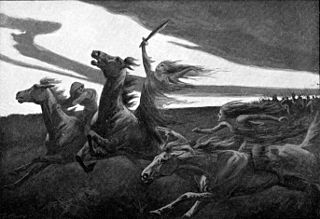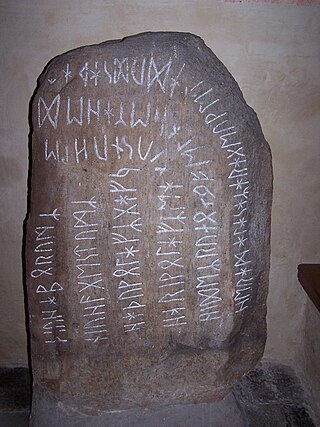Related Research Articles
Ægir, Hlér, or Gymir, is a jötunn and a personification of the sea in Norse mythology. In the Old Norse record, Ægir hosts the gods in his halls and is associated with brewing ale. Ægir is attested as married to a goddess, Rán, who also personifies the sea, and together the two produced daughters who personify waves, the Nine Daughters of Ægir and Rán, and Ægir's son is Snær, personified snow. Ægir may also be the father of the beautiful jötunn Gerðr, wife of the god Freyr, or these may be two separate figures who share the same name.

Yule is a winter festival historically observed by the Germanic peoples that was incorporated into Christmas during the Christianisation of the Germanic peoples. In present times adherents of some new religious movements celebrate Yule independently of the Christian festival. Scholars have connected the original celebrations of Yule to the Wild Hunt, the god Odin, and the heathen Anglo-Saxon Mōdraniht. The term Yule and cognates are still used in English and the Scandinavian languages as well as in Finnish and Estonian to describe Christmas and other festivals occurring during the winter holiday season. Furthermore, some present-day Christmas customs and traditions such as the Yule log, Yule goat, Yule boar, Yule singing, and others may have connections to older pagan Yule traditions.

The Orkneyinga saga is a narrative of the history of the Orkney and Shetland islands and their relationship with other local polities, particularly Norway and Scotland. The saga has "no parallel in the social and literary record of Scotland" and is "the only medieval chronicle to have Orkney as the central place of action". The main focus of the work is the line of jarls who ruled the Earldom of Orkney, which constituted the Norðreyjar or Northern Isles of Orkney and Shetland and there are frequent references to both archipelagoes throughout.

In Norse mythology, a dís is a female deity, ghost, or spirit associated with Fate who can be either benevolent or antagonistic toward mortals. Dísir may act as protective spirits of Norse clans. It is possible that their original function was that of fertility goddesses who were the object of both private and official worship called dísablót, and their veneration may derive from the worship of the spirits of the dead. The dísir, like the valkyries, norns, and vættir, are always referred collectively in surviving references. The North Germanic dísir and West Germanic Idisi are believed by some scholars to be related due to linguistic and mythological similarities, but the direct evidence of Anglo-Saxon and Continental German mythology is limited. The dísir play roles in Norse texts that resemble those of fylgjur, valkyries, and norns, so that some have suggested that dísir is a broad term including the other beings.

Thor is a prominent god in Germanic paganism. In Norse mythology, he is a hammer-wielding god associated with lightning, thunder, storms, sacred groves and trees, strength, the protection of humankind, hallowing, and fertility. Besides Old Norse Þórr, the deity occurs in Old English as Thunor, in Old Frisian as Thuner, in Old Saxon as Thunar, and in Old High German as Donar, all ultimately stemming from the Proto-Germanic theonym *Þun(a)raz, meaning 'Thunder'.
Rognvald Eysteinsson was the founding Jarl of Møre in Norway, and a close relative and ally of Harald Fairhair, the earliest known King of Norway. In the Norse language he is known as Rǫgnvaldr Eysteinsson (Mǿrajarl) and in modern Norwegian as Ragnvald Mørejarl. He is sometimes referred to with bynames that may be translated into modern English as "Rognvald the Wise" or "Rognvald the Powerful".

Old Norse religion, also known as Norse paganism, is a branch of Germanic religion which developed during the Proto-Norse period, when the North Germanic peoples separated into a distinct branch of the Germanic peoples. It was replaced by Christianity and forgotten during the Christianisation of Scandinavia. Scholars reconstruct aspects of North Germanic Religion by historical linguistics, archaeology, toponymy, and records left by North Germanic peoples, such as runic inscriptions in the Younger Futhark, a distinctly North Germanic extension of the runic alphabet. Numerous Old Norse works dated to the 13th-century record Norse mythology, a component of North Germanic religion.
Kvenland, known as Cwenland, Qwenland, Kænland, and similar terms in medieval sources, is an ancient name for an area in Fennoscandia and Scandinavia. Kvenland, in that or nearly that spelling, is known from an Old English account written in the 9th century, which used information provided by Norwegian adventurer and traveler Ohthere, and from Nordic sources, primarily Icelandic. A possible additional source was written in the modern-day area of Norway. All known Nordic sources date from the 12th and 13th centuries. Other possible references to Kvenland by other names and spellings are also discussed here.
Nór is according to the Orkneyinga Saga the eponymous founder of Norway.
Fornjót is a jötunn in Norse mythology, and the father of Hlér ('sea'), Logi ('fire') and Kári ('wind'). It is also the name of a legendary king of "Finland and Kvenland". The principal study of this figure is by Margaret Clunies Ross.
In Norse mythology, Snær is seemingly a personification of snow, appearing in extant text as an euhemerized legendary Scandinavian king.
Hversu Noregr byggðist is an account of the origin of various legendary Norwegian lineages, which survives only in the Flateyjarbók. It traces the descendants of the primeval Fornjót, a king of "Gotland, Kænland and Finnland", down to Nór, who is here the eponym and first great king of Norway, and then gives details of the descendants of Nór in a following section known as the Ættartölur, 'Genealogies'.

Blót or geblōt are religious ceremonies in Germanic paganism that centred on the killing and offering of an animal to a particular being, typically followed by the communal cooking and eating of its meat. Old Norse sources present it as a central ritual in Old Nordic religion that was intimately connected with many wider aspects of life. Large blót are often described as taking place in halls, organised by the rulers of the region who were expected to carry out the practice on behalf of the people. Blót were central to the legitimacy of rulers and Christian rulers refusing to hold them were at times replaced by more willing alternatives and driven out of the land. Smaller, household blót were sometimes recorded as being led by women. Beyond strengthening legitimacy for the ruling elites, the performance of blót was often in order to ensure the fertility of the land, a good harvest and peace, although they are also recorded as being performed for divination or to achieve desired results in legal matters.
Einarr Rognvaldarson, often referred to by his byname Torf-Einarr, was one of the Norse earls of Orkney. The son of the Norse jarl Rognvald Eysteinsson and a concubine, his rise to power is related in sagas which apparently draw on verses of Einarr's own composition for inspiration. After battling for control of the Northern Isles of Scotland and a struggle with Norwegian royalty, Einarr founded a dynasty which retained control of the islands for centuries after his death.
Rolf is a male given name and a surname. It originates in the Germanic name Hrolf, itself a contraction of Hrodwulf (Rudolf), a conjunction of the stem words hrod ("renown") + wulf ("wolf"). The Old Norse cognate is Hrólfr. An alternative but less common variation of Rolf in Norway is Rolv.
The Norse mythology, preserved ancient Icelandic texts such as the Poetic Edda, the Prose Edda, and other lays and sagas, was little known outside Scandinavia until the 19th century. With the widespread publication of Norse myths and legends at this time, references to the Norse gods and heroes spread into European literary culture, especially in Scandinavia, Germany, and Britain. In the later 20th century, references to Norse mythology became common in science fiction and fantasy literature, role-playing games, and eventually other cultural products such as Japanese animation. Storytelling was an important aspect of Norse mythology and centuries later, with the rediscovery of the myth, Norse mythology once again relies on the impacts of storytelling to spread its agenda.

Sigurd Eysteinsson, or Sigurd the Mighty, was the second Jarl of Orkney—a title bequeathed to Sigurd by his brother Rognvald Eysteinsson. A son of Eystein Glumra, Sigurd was a leader in the Viking conquest of what is now northern Scotland.
A few Icelandic sagas tell about kings that ruled in Kvenland.
Þorrablót is an Icelandic midwinter festival, named for the month of Þorri of the historical Icelandic calendar, and blót, literally meaning sacrifice.

In the modern pagan movement of Heathenry there are a number of holidays celebrated by different groups and individuals. The most widely observed are based on ancient Germanic practices described in historical accounts or folk practices; however, some adherents also incorporate innovations from the 20th and 21st centuries.
References
- ↑ English translation of "How Norway was settled" by Dasent 1894
- ↑ Mikko Heikkilä (2012), On the Etymology of Certain Names in Finnic Mythology (also based on Dasent translation of "How Norway was settled"), SKY Journal of Linguistics
- ↑ Georg Friedrich Creuzer, Franz Joseph Mone, Symbolik und Mythologie der alten Völker, besonders der Griechen, Heyer und Leske, 1822, p. 275.
- ↑ Martin Nilsson, Primitive Time-Reckoning; A Study in the Origins and First Development of the Art of Counting Time (1920), p. 301.
- ↑ Árni Björnsson, Icelandic feasts and holidays, 1980, p. 16.
- ↑ Andrew Evans, Iceland, Bradt Travel Guides, 2008, ISBN 978-1-84162-215-6, p. 29.